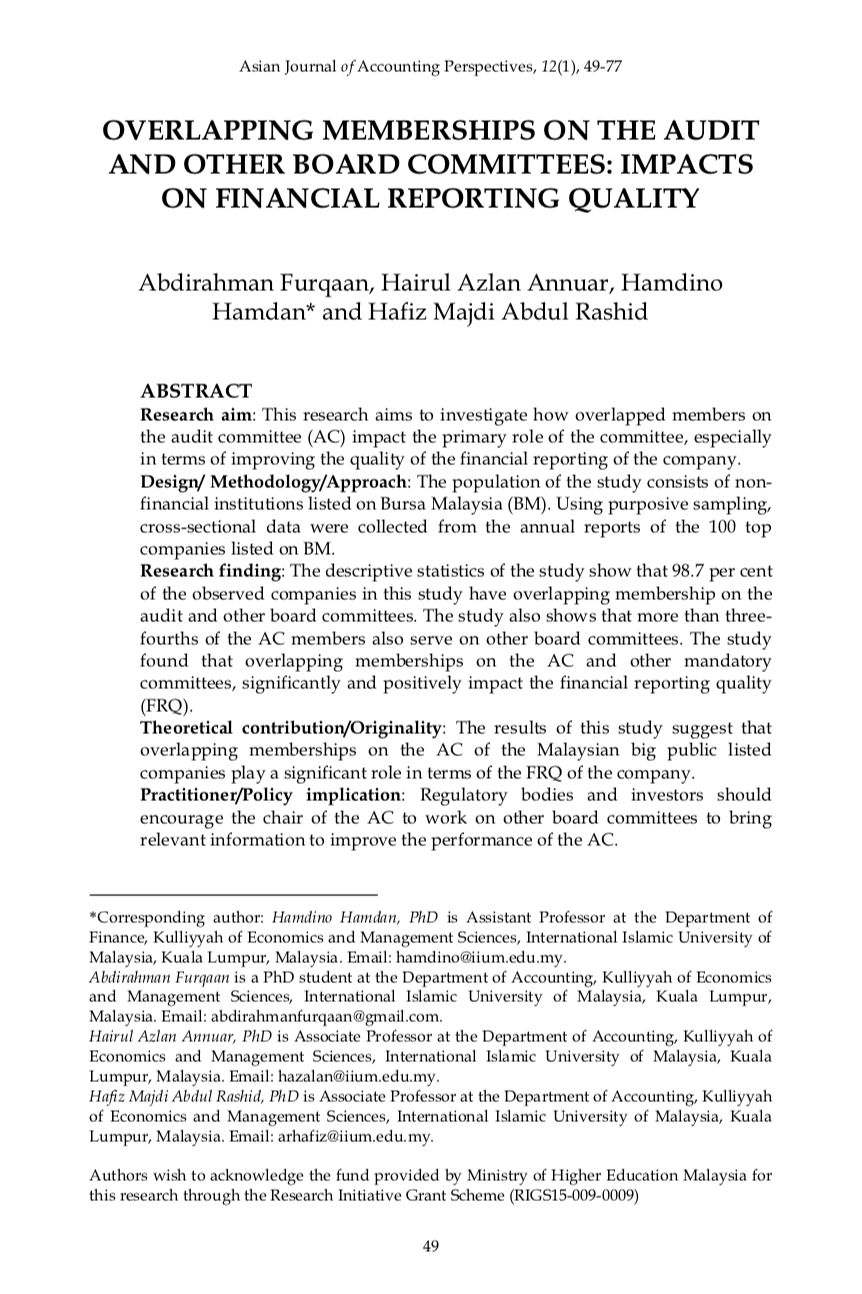Overlapping Memberships on The Audit and Other Board Committees: Impacts on Financial Reporting Quality
Main Article Content
Abstract
Research aim: This research aims to investigate how overlapped members on the audit committee (AC) impact the primary role of the committee, especially in terms of improving the quality of the financial reporting of the company.
Design/ Methodology/Approach: The population of the study consists of non-financial institutions listed on Bursa Malaysia (BM). Using purposive sampling, cross-sectional data were collected from the annual reports of the 100 top companies listed on BM.
Research finding: The descriptive statistics of the study show that 98.7 per cent of the observed companies in this study have overlapping membership on the audit and other board committees. The study also shows that more than three-fourths of the AC members also serve on other board committees. The study found that overlapping memberships on the AC and other mandatory committees, significantly and positively impact the financial reporting quality (FRQ).
Theoretical contribution/Originality: The results of this study suggest that overlapping memberships on the AC of the Malaysian big public listed companies play a significant role in terms of the FRQ of the company.
Practitioner/Policy implication: Regulatory bodies and investors should encourage the chair of the AC to work on other board committees to bring relevant information to improve the performance of the AC.
Research limitation/Implication: The inherent drawback of the current research is the small sample size, and that it does not provide in-depth and comprehensive data from the documents of the company. The research sample was drawn from the largest 100 Malaysian companies. Therefore, the results of the study may not be generalisable to smaller companies.
Keywords: Overlapping memberships, Audit committee (AC), Remuneration committee (RC), Nomination committee (NC), Financial Reporting Quality (FRQ)
Type of manuscript: Research paper
JEL Classification: M40
Downloads
Article Details
License
The Asian Journal of Accounting Perspectives (AJAP) articles are published under a licence equivalent to the Creative Commons Attribution-NonCommercial-NoDerivs License (CC BY-NC-ND). The licence allows users to copy, distribute, and transmit an article as long as the author is attributed. The article is not used for commercial purposes. The work is not modified or adapted in any way.
Copyright
Authors are required to sign the Exclusive License to Publish agreement upon publication in the AJAP. The agreement grants the Publisher (Faculty of Business and Accountancy, Universiti Malaya) to publish and disseminate the articles.
Open Access
Articles published in the AJAP are digital, online, free of charge, and free of most copyright and licensing restrictions.
Article Processing Charge
Articles publish in AJAP is free submission, production and publication charges. However, all accepted articles are required for language editing. The AJAP officially appointed and outsourced proofreader will conduct this process, and the authors will cover the cost. AJAP does not profit from this process and transaction.
References
Alves, S. (2013). The impact of audit committee existence and external audit on earnings management Evidence from Portugal. Journal of Financial Reporting and Accounting, 11(2), 143–165.
Annuar, H. A., & Abdul Rashid, H. M. (2015). An investigation of the control role and effectiveness of independent non-executive directors in Malaysian public listed companies. Managerial Auditing Journal, 30(6/7), 582–609.
Bruynseels, Liesbeth, Krishnamoorthy, G., & Wright, A. (2016). The association between audit committee characteristics and audit fees. Auditing, 22.
Carson, E. (2002). Factors Associated with the Development of Board Sub-committees. Corporate Governance, 10(1), 4–18.
Chandar, N., Chang, H., & Zheng, X. (2012). Does overlapping membership on audit and compensation committees improve a company’s FRQ ? Review of Accounting and Finance, 11(2), 141–165.
Chang, J. C., Luo, M., & Sun, H. L. (2011). The Impact of Independent and Overlapping Board Structures on CEO Compensation, Pay-Performance Sensitivity and Accruals Management. Quarterly Journal of Finance and Accounting, 50(2), 54–84.
Cohen, J., Hoitash, U., Krishnamoorthy, G., & Wright, A. (2014). The Effect of Audit Committee Industry Expertise on Monitoring the Financial Reporting Process. The Accounting Review, 89(1), 243–273.
Cowen, S. S., & Carolina, N. (1987). The impact of corporate characteristics on social responsibility disclosure: A typology and frequency-based analysis. Accounting Organization and Society, 12(2), 111–122.
Eyenubo, S. A., Mohammed, M. & Ali, M. (2017). Audit Committee Effectiveness of Financial Reporting Quality in Listed companies in Nigeria Stock Exchange. International Journal of Academic Research in Business and Social Sciences, 7(6), 487-505.
Fama, E. F., & Jensen, M. C. (1983). Separation of Ownership and Control. Journal of Law and Economics, 26(2) 301-325.
Habib, A. & Uddin Bhuiyan, M. B. (2016). Overlapping membership on audit and compensation committees, audit committee equity holdings, and financial reporting quality. Australian Accounting Review, 26(1), 76-90.
Habib, A., & Jiang, H. (2015). Corporate governance and FRQ in China: A survey of recent evidence. Journal of International Accounting, Auditing and Taxation, 24(C), 29-45.
Harris, I. C., & Shimizu, K. (2004). Too busy to serve? An examination of the influence of overboarded directors. Journal of Management Studies, 41(5), 775-798.
Hoitash, R., Hoitash, U., & Bedard, J. C. (2009). Corporate governance and internal control over financial reporting. The Accounting Review, 84(3), 839-867.
Johl, S.K., Johl, S.K., Subramaniam, N. and Cooper, B. (2013). Internal audit function, board quality and financial reporting quality: evidence from Malaysia. Managerial Auditing Journal, 28(9), 780-814.
Khurana, I. K., & Raman, K. K. (2004). Are big four audits in ASEAN countries of higher quality than non-big four audits? Asia-Pacific Journal of Accounting & Economics, 11(2), 139-165.
Kalelkar, R. (2017). Effect of audit and compensation committee membership overlap on audit fees. Asian Review of Accounting, 25(1), 34-57.
Klein, A. (2002a). Audit Committee Independence. Review Literature and Arts of The Americas, 77(2), 435-452.
Klein, A. (2002b). Audit committee, board of director characteristics, and earnings management. Journal of Accounting and Economics, 33(3), 375-400.
Kobori, K. & Hutchinson, R. (2015). The Influence of External Auditors, Capital Markets, and Main Banks on Earnings Manipulations: Evidence from Japan. Journal of Accounting and Finance, 15(8), 69-80.
Kothari, S. P., Leone, A. J., & Wasley, C. E. (2005). Performance matched discretionary accrual measures. Journal of Accounting and Economics, 39(1), 163-197.
Kusnadi, Y., Leong, K. S., Suwardy, T., & Wang, J. (2016). Audit committees and financial reporting quality in Singapore. Journal of Business Ethics, 139(1), 197-214.
Laux, C., & Laux, V. (2009). Board Committees, CEO Compensation, and Earnings Managment. The Accounting Review, 84(3), 869-891.
Liao, C. H., & Hsu, A. W. H. (2013). Common Membership and Effective Corporate Governance: Evidence from Audit and Compensation Committees. Corporate Governance (Oxford), 21(1), 79-92.
Mackenzie, C. (2007). Boards, Incentives and Corporate Social Responsibility: the case for a change of emphasis, Corporate Governance: An International Review, 15(5), 935-943.
Main, B. G. M., Jackson, C., Pymm, J., & Wright, V. (2008). The Remuneration Committee and Strategic Human Resource Management. Corporate Governance: An International Review, 16(3), 225-238.
MCCG. (2012). Malaysian Code on on Corporate Governance. Securities Commision. Kuala Lampur.
Nelson, S. P., & Devi, S. (2013). Audit committee experts and earnings quality. Corporate Governance, 13(4), 335-351.
Oussii, A. A., & Taktak, N. B. (2018). Audit committee effectiveness and financial reporting timeliness: The case of Tunisian listed companies. African Journal of Economic and Management Studies, 9(1), 34-55.
Rahman, R. A., & Ali, F. H. M. (2006). Board, audit committee, culture and earnings management: Malaysian evidence. Managerial Auditing Journal, 21(7), 783-804.
Rashid, N. M., Noor, R. M., Matsuki, N., Abrahman, N. A., & Omar, N. (2016). The Longitudinal Study of Earnings Management: Analysis on Companies Financial Abilities. Procedia Economics and Finance, 35(16), 136-145.
Salehi, M. & Shirazi, M. (2016). Audit committee impact on the quality of financial reporting and disclosure: Evidence from the Tehran Stock Exchange. Management Research Review, 39(12), 1639-1662.
Salleh, K., & Jasmani, H. (2014). Audit Rotation and Audit Report: Empirical Evidence from Malaysian PLCs over the Period of Ten Years. Procedia - Social and Behavioral Sciences, 145, 40-50.
Spira, L. F., & Bender, R. (2004). Compare and Contrast: perspectives on board committees*, 12(4), 489–499.
Vafeas, N. (1999). The nature of board nominating committees and their role in corporate governance. Journal of Business Finance and Accounting, 26(1-2), 199-225.
Yang, C. Y., Hung-Neng, L., & Boon Leing, T. (2008). Managerial Ownership Structure and Earnings Management. Journal of Financial Reporting and Accounting, 6(1), 35-53.
Yatim, P. (2010). Board structures and the establishment of a risk management committee by Malaysian listed firms. Journal of Management and Governance, 14(1), 17-36.
Zgarni, I., Hlioui, K., & Zehri, F. (2016). Effective audit committee, audit quality and earnings management: Evidence from Tunisia. Journal of Accounting in Emerging Economies, 6(2), 138-155.

